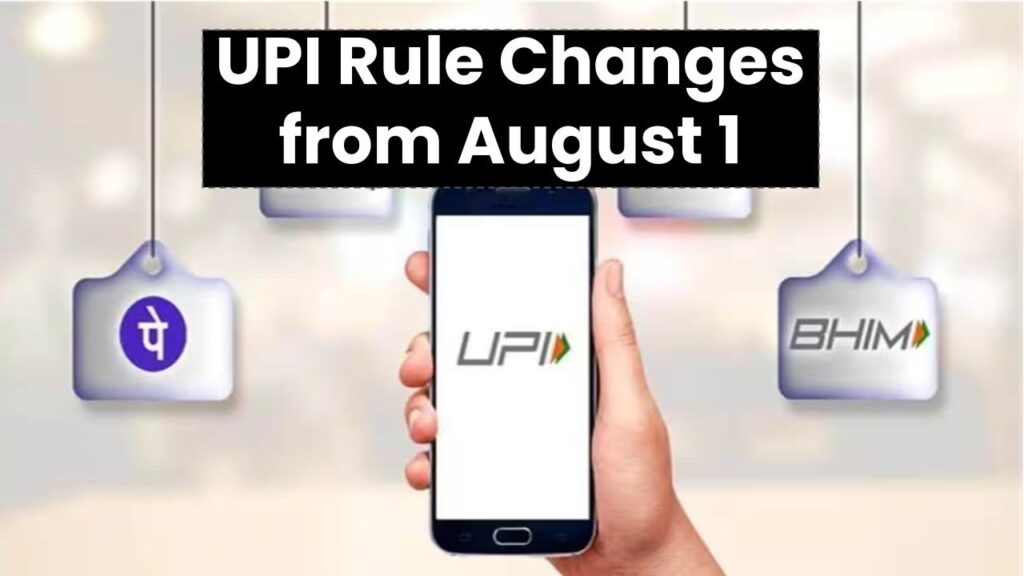If you use Google Pay (GPay), PhonePe, or Paytm to send or receive money in India, then you really need to know about the new UPI rule changes from August 1, 2025. The National Payments Corporation of India (NPCI), which runs the Unified Payments Interface (UPI) system, is rolling out some major updates. And trust me, these changes will affect your daily transactions, whether you’re just paying for chai or running a full-blown business online.

UPI Rule Changes from August 1
| Feature | New Rule | Why It Matters |
|---|---|---|
| Balance Check Limit | 50 times/day per app | Avoids system overload |
| Linked Account Info Access | 25 times/day per app | Protects from misuse |
| Transaction Status Checks | 3 times per transaction (with 90 sec gap) | Reduces network spam |
| AutoPay Time Slots | Only 3 time windows allowed | Smooths traffic, avoids failures |
| Inactive Mobile Numbers | Auto-deactivation after 1 year of inactivity | Prevents fraud |
These UPI rule changes from August 1 might seem annoying at first glance, but they’re actually smart moves. They aim to make India’s most popular digital payment system more stable, secure, and user-friendly.
From limiting daily balance checks to deactivating inactive IDs, it’s all about keeping the system clean and efficient. Whether you’re a teenager paying for lunch or a CEO settling invoices, a little awareness now will save you a ton of stress later.
What Is UPI and Why the Changes?
Unified Payments Interface, or UPI, is India’s real-time digital payment system. You use it when you scan a QR code, send rent to your landlord, or split a dinner bill. And with over 13 billion transactions processed in a single month (Feb 2025), UPI is growing faster than ever.
But here’s the catch: with that kind of volume, the network can get crazy congested. So, the NPCI is introducing these rule changes to protect the system from overload, reduce fraud, and ensure smoother performance.
Breakdown of the 5 Major UPI Rule Changes
1. Daily Balance Check Limit – 50 Times per App
Until now, there was no hard limit on how often you could check your bank balance through UPI apps like GPay or PhonePe. But starting August 1, you can only do it 50 times per app, per day.
Why? Because constant balance checks clog the system. Think of it like refreshing Instagram every 5 seconds – it adds up. So if you’re a heavy user, keep tabs on your balance requests.
2. Linked Bank Account Info Access Limited to 25 Times/Day
Ever tap “View linked bank accounts” to double-check where your money’s going? Now, that option is capped at 25 times a day per app.
This helps limit unauthorized peeking into your linked account details. It’s a simple way to enhance user data privacy and protect you from phishing apps.
3. Status Refresh Limits for Pending Transactions
When a UPI payment hangs, we tend to hammer that “Check Status” button over and over. Guilty as charged? Now, you get just three attempts per pending transaction, and each must be at least 90 seconds apart.
Why It Matters: It keeps the system from being overloaded and helps avoid accidental double-spending.
4. AutoPay Execution Limited to Time Windows
Auto-debits for Netflix, gym memberships, or insurance? These will now only process in specific time slots:
- Before 10 AM
- 1 PM to 5 PM
- After 9:30 PM
This helps NPCI avoid the chaos of simultaneous debits and ensures smoother transaction processing.
5. Auto-Deactivation of Inactive Mobile Numbers & UPI IDs
UPI IDs linked to mobile numbers that haven’t been active for over a year will be automatically deactivated.
This is a big move to prevent fraud using dormant or recycled numbers. If you switched SIMs or numbers recently, update your UPI settings pronto.
What Professionals, Merchants & Freelancers Should Know
If you’re running a business or working as a freelancer, here’s what to keep in mind:
- Track Autopay Schedules: Plan around new debit windows for vendors, utilities, and SaaS tools.
- Educate Staff: Make sure employees handling payments know the new daily check and view limits.
- Customer Service Prep: If a customer says a payment didn’t go through, wait out the 90-second refresh rule.
Important: No changes are being made to the daily transaction limits (still Rs. 1 lakh per day for most users).
FAQs
Will these rules affect how much I can send or receive via UPI?
No. Your transaction limits remain the same. These rules affect usage behavior, not payment caps.
Can I still use multiple UPI apps?
Yes! And each app has its own limits. So GPay and PhonePe have separate balance/view caps.
What if my UPI ID gets deactivated?
If your mobile number has been inactive for over a year, your UPI ID will be removed. Just re-register with a new number or activate the old one.
Are these changes permanent?
As of now, yes. But NPCI may tweak rules depending on traffic, security, and user feedback.
Practical Tips to Stay Ahead
1. Don’t Over-Check Your Balance
Use widgets, SMS alerts, or your banking app to track balance efficiently.
2. Monitor AutoPay Debits
Set calendar reminders to keep your balance ready during the new time windows.
3. Stay on Top of SIM Changes
Switching phones or numbers? Update your UPI profile immediately.
4. Use Multiple Apps Wisely
Split your usage across apps to avoid hitting limits on any single one.
5. Educate Your Family & Team
Forward this article or create a quick cheat sheet for your household or staff.








